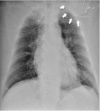Twiddler's Syndrome
- PMID: 31404310
- PMCID: PMC6682220
- DOI: 10.5811/cpcem.2019.4.42123
Twiddler's Syndrome
Abstract
Twiddler's syndrome refers to a rare condition in which a pacemaker or automatic implantable cardioverter-defibrillator (AICD) malfunctions due to coiling of the device in the skin pocket and resultant lead displacement. This image is the chest radiograph (CXR) of a 54-year-old male who presented to the emergency department with chest pain five months after his AICD was placed. The CXR shows AICD leads coiled around the device and the absence of leads in the ventricle consistent with Twiddler's syndrome. Patients with twiddler's syndrome should be admitted for operative intervention.
Conflict of interest statement
Conflicts of Interest: By the CPC-EM article submission agreement, all authors are required to disclose all affiliations, funding sources and financial or management relationships that could be perceived as potential sources of bias. The authors disclosed none.
Figures
References
-
- Bardy GH, Lee KL, Mark DB, et al. Amiodarone or an implantable cardioverter–defibrillator for congestive heart failure. N Engl J Med. 2005;352(3):225–37. - PubMed
-
- Moss AJ, Hall WJ, Cannom DS, et al. Improved survival with an implanted defibrillator in patients with coronary disease at high risk for ventricular arrhythmia. N Engl J Med. 1996;335(26):1933–40. - PubMed

